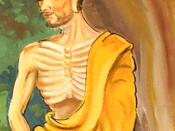Siddhartha's Maturation as Marked by Key Experiences
Siddhartha, by Herman Hesse is the story of a young Indian noble who ventures off in the world to find an understanding of the meaning of life. His journey begins as a young Brahmin who yearned to unwind the complexities of his existence. He ends as an old sage who has found peace within himself and his surroundings. Throughout the book, Hesse allows the reader to trace Siddhartha's maturation process both through his experiences, and people with whom he comes in contact. During his journey, he makes a number of choices, "turns", that put him on a path of his maturation which is marked by self discovery and independence. Siddhartha's maturation is developed by three key events: his meeting with Buddha, his attempted suicide, and the arrival/departure of his son, as they all contribute to his self discovery and individuality.
Siddhartha's meeting with Gautama, the Buddha, is the first key experience that contributes to his maturation process.
After several years of living the ascetic life of a Samana, Siddhartha decides to seek out Gautama, "The Illustrious One," as a possible source of assistance in his journey to find his inner self. After their meeting, however, Siddhartha becomes more convinced that the Buddha's methods satisfy his logical and tangible needs, but will not bring him any closer to realizing his spiritual and metaphysical needs. The theme of maturity presents itself in Siddhartha's conclusion that if he is to achieve an immaterial balance, it must be on his own. He understands that the Buddha had a remarkable experience, but it is a personal one. Siddhartha sees that his development process relies on his forging his own experiences, and his attainment of self realization can only be made by himself, regardless of what knowledge Gautama...


